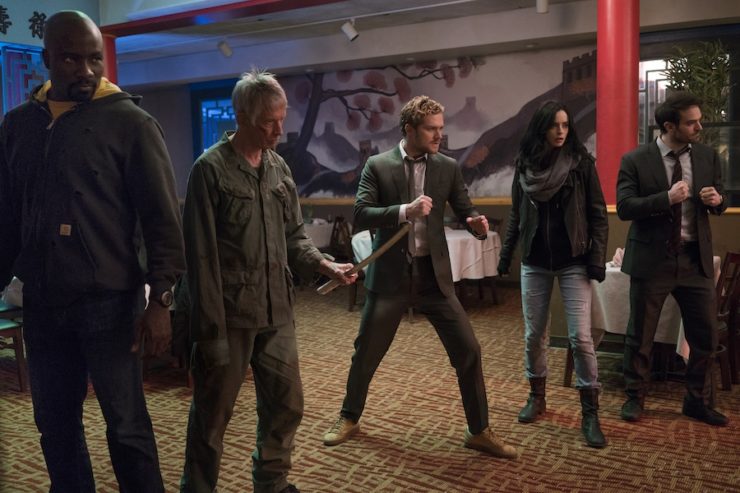By the time we get to the end of Marvel’s The Defenders, that word (“defenders”) has never been used. It’s kind of fitting, really, since the original comic book version of the Defenders were a so-called “non-team” featuring a rotating and inconsistent cast, and the team was never really formalized or set.
In that same vein, Daredevil, Iron Fist, Jessica Jones, and Luke Cage never really become a formal team. Hell, the “team,” such as it is, isn’t really just those four, as Claire Temple, Misty Knight, and especially Colleen Wing are important components of the fight, too.
And that is what makes The Defenders particularly strong, as the characterizations of all its players, big and small, is superb.
If only the plot was stronger…
SPOILERS for The Defenders season 1.
Probably the most impressive feat of this series is that it manages to pick up and tie together so many threads. There’s a serious juggling act going on here, as all of the following storylines get play in The Defenders:
- Wilson Fisk’s dodgy real-estate consortium, specifically Madame Gao’s role in it, from Daredevil season 1
- Jessica Jones recovering from her battle against Kilgrave in her show’s first season
- Luke Cage getting out of prison and trying to continue his role as Harlem’s hero from his show’s first season
- The Hand, Elektra’s role as the Black Sky, and Stick’s war against them from Daredevil season 2
- Also from DD season 2, Matt Murdock trying to get away from the double life that is driving him away from those he loves (and got Elektra killed)
- Danny Rand’s guilt over failing to save K’un Lun in Iron Fist season 1
- Colleen Wing’s guilt over not realizing that the Hand was evil in that same season
- Claire Temple’s general role as the glue holding all these folks together in all of the above
Not only that, but some of these are bits that didn’t work particularly well before, but stand out quite well now, starting with the Hand. In DD season 2 and IF season 1 they were a cultish force, kinda, with lots of ninjas, but not really focused. In The Defenders, we finally find out what they are—and also why they seem inconsistent. The Hand are actually five people who rejected the teachings of K’un Lun and rebelled against them, getting their hands on a substance (called, prosaically, “the substance”) that enables them to come back from the dead. The five of them—they’re the fingers of the Hand—include the previously seen Gao and Bakuto (the latter introduced in Iron Fist, and seemingly killed by Wing), as well as Murakami, Sowande, and Alexandra.
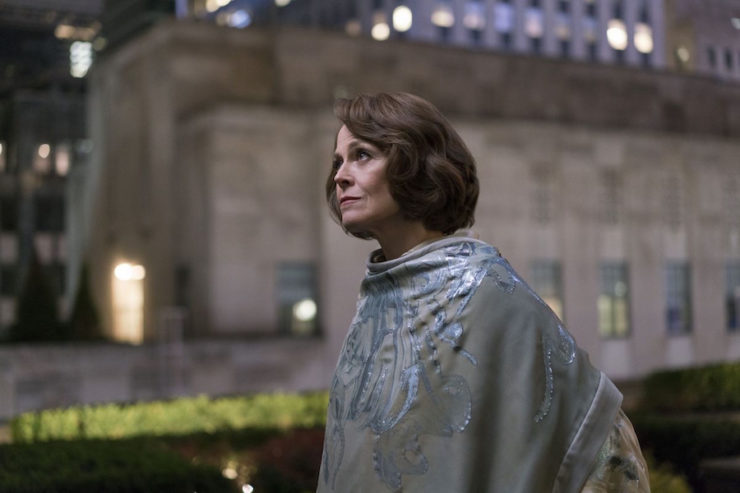
The latter is played by Sigourney Weaver, and she is as superb as ever. Alexandra has a grace and meticulousness and calm that comes of living a very long time. Best of all, she doesn’t have an explosive side. That was honestly starting to get repetitive in the Netflix MCU series, as we had Fisk, Kilgrave, Cottonmouth, Mariah, and Harold Meachum, all of whom were generally calm and reasonable but with explosive tempers that could lash out at any moment. So it’s a welcome change to have Alexandra not be like that. She takes everything in stride, from Rand having unexpected help from Murdock, Jones, and Cage to the other four members of the Hand expressing major issues with her plan to a simple annoyance like a record skipping on a scratch. Even when she has her biggest triumph, when Elektra brings Rand to her, thus enabling their plan to go forth, and she bitches out the (surviving) other Hand members, she’s completely calm, and only a little angry.
Of course, that’s followed by her biggest failure, as Elektra kills her. There are two things Alexandra didn’t anticipate. One was Rand having so many skilled allies, including three with super-powers. The other was Elektra’s betrayal. Alexandra was convinced that Elektra was only the Black Sky now, but Elektra’s original personality did come to the fore. However, she still wants access to the substance—which is apparently in a chamber that only the iron fist can open. And appears to be made of bones. Maybe dragon bones?
Removing the substance will destroy the city above, which the Hand has apparently previously done in Pompeii and Chernobyl. It’s not clear how removing dragon bones (or whatever) will destroy a city or why, in a world filled with super-powered beings (including two in this very series) it has to be the iron fist that breaks into the chamber that holds the substance. I mean, Cage or Jones or the Hulk or Spider-Man or anyone with a fancy-ass exoskeleton like Iron Man or the Vulture could do it just as easily. (EDITED TO ADD: As has been pointed out in the comments, Gao told Alexandra after the earthquake that the wall was warded against a physical attack, and only the mystical power of the iron fist could get through. In the words of Luke Cage, “My bad!”)
And this is the overall problem with The Defenders. The threat is vague and undefined—we keep being told the city is in danger, but aside from one earthquake, that danger never really manifests. I don’t expect aliens attacking Grand Central Terminal (Disney doesn’t give them a big enough budget for that), but there should’ve been something a bit more concrete to threaten the city than “we’re digging a hole and taking bones out.”
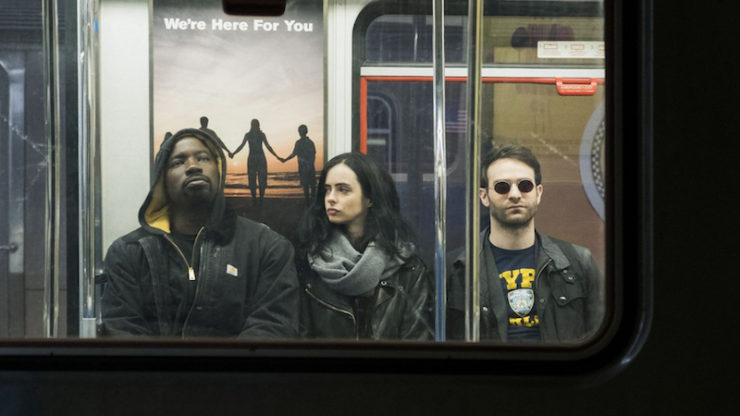
It doesn’t help that the show doesn’t have the same feel for New York that the previous series did, particularly Luke Cage and Daredevil. The city in general and the neighborhoods of Harlem and Hell’s Kitchen (however fictionalized those neighborhoods are for the sake of the stories) forms the texture for Murdock and Cage’s stories. Even Jessica Jones and Iron Fist integrated the city into the background, at least. But The Defenders never really feels like it’s taking place in New York the way the others do, and considering how much hype there was about the “battle for New York,” the inability to embrace the location with the same verve that its predecessors managed is a disappointment. (There’s also some geographical hilarity, like putting a seedy bar on 11th Avenue in the 40s, an area that is mostly car dealerships, not bars…)
On top of that, for all that Elektra killing Alexandra was an effective end to episode 6, it also really took the wind out of the sails of the finale. Elektra and Murdock do get to indulge in their banter and self-destructive antics that kept her half of DD season 2 from being a complete disaster, but Elektra has none of Alexandra’s powerful charisma. She’s a tormented mess—that’s what Elektra has always been, both in the comics and onscreen—and she doesn’t have anywhere near the gravitas that is required to lead the Hand.
And while Gao provides pointed commentary to Elektra about how important Alexandra’s resources and relationships cultivated over the centuries are to the Hand’s success and how Elektra can’t just assume those because she killed her, there’s no time to really dig into it, because there’s the big-ass climax. The surviving Hand folk need to get at the substance regardless of who’s in charge—as it is, two of their number are dead (Sowande having been killed by Stick, and seriously, guys, you had to kill the black guy first? nice job of tone-deafness, there…)—so they go along with it.
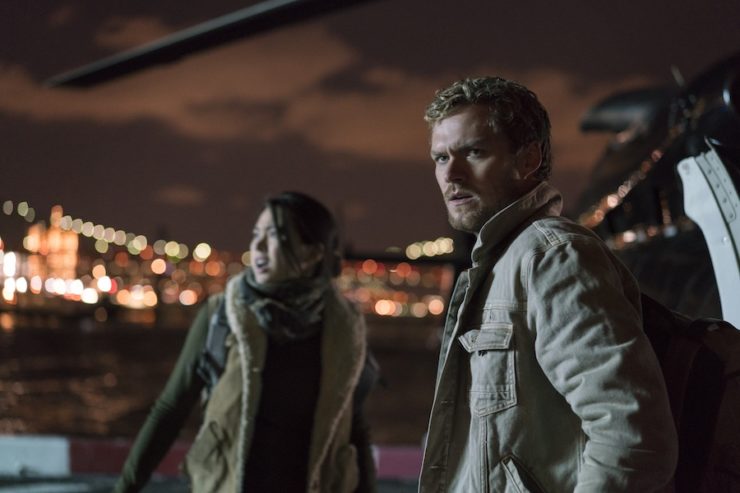
That big-ass climax does work superbly, though. With the notable (and glaring) exception of Iron Fist, the Netflix MCU has done excellent work with action scenes, and that continues here. Finn Jones still doesn’t move like the living weapon, but he’s marginally better than he was in IF; both Mike Colter and Krysten Ritter move with the same casual fighting style that we saw in both Jessica Jones and Luke Cage, Jones as the irresistible force and Cage as the immovable object. And both Charlie Cox and his stunt double remain magnificent. Plus we have the added bonus of Jessica Henwick’s Wing getting another swordfight against Bakuto, and winning somewhat more permanently.
(By the way, there’s a delightful Easter egg early on. We see Rand and Wing in the latter’s dojo, with Rand lying on the floor, using a couple of Wing’s books as a pillow. On top of the pile is the very distinctive cover of Karate-Dō: My Way of Life by Gichin Funakoshi, the father of modern karate, and a book I strongly recommend to anyone who’s interested in martial arts in any form. By putting the book there, the set designers showed more knowledge of martial arts than anyone involved with Iron Fist’s first season…)
But while the plot doesn’t entirely cohere, the characterization truly shines. Murdock, Cage, and Jones were already strong, complex characters before the series started, as are Temple and Wing and Knight, and their arcs all continue along and intersect and take odd detours. Jones and Murdock’s banter is a delight—I particularly like when she uses the info she dug up on him to help interrogate her client’s daughter—and Cage and Rand have three different, brilliantly written and performed conversations over the course of the series that presages a future series pairing up the two of them. (Will I finally, after thirty years, get the Power Man & Iron Fist TV show I’ve been dreaming of?)
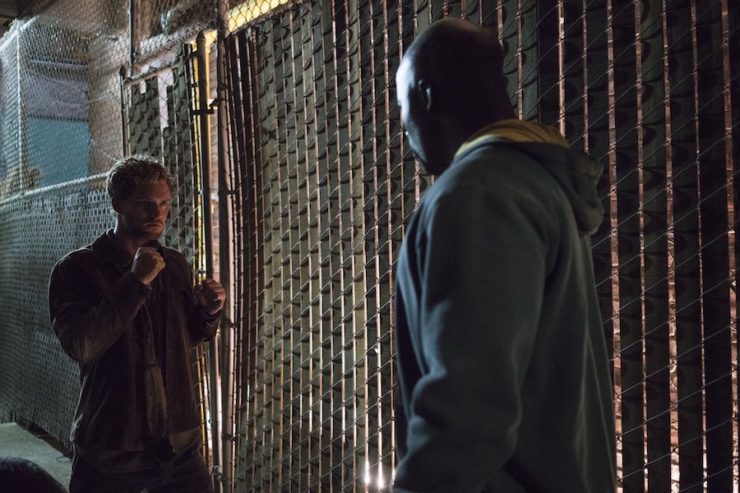
I didn’t list Rand as a strong, complex character above, but Defenders makes that work, too. In Iron Fist, Rand was a whiny, arrogant, twerp that the script kept trying to crowbar into a hero. In The Defenders, Rand is a whiny, arrogant twerp that the script comes right out and acknowledges is a whiny, arrogant twerp. It makes the character a whole lot easier to take, especially given how often the other characters call him on it. (Best line of the whole series belongs to Stick, speaking for the entire audience: “The immortal Iron Fist is still a thundering dumbass.”)
Best of all, the show doesn’t skimp on its supporting characters. Foggy Nelson and Karen Page are trying to move on with their lives while trying to keep Murdock from going back to being Daredevil, though Nelson winds up enabling him. Murdock’s slice of The Defenders is very much an addiction story, with Nelson and Page acting exactly like the friends the addict has alienated with his behavior, and Murdock treats the suit exactly like a hit from his drug of choice. It’s brilliantly written, down to the very end when Murdock is believed to have been buried alongside Elektra and Gao (my money’s on all three, not just Murdock, surviving, though DD is the only one we see at the end). The scene where Cage, Jones, and Rand all arrive at the police precinct to meet up with their loved ones, but Nelson and Page are left standing there watching an empty doorway waiting for Murdock to arrive, which he never does, is brutally effective.
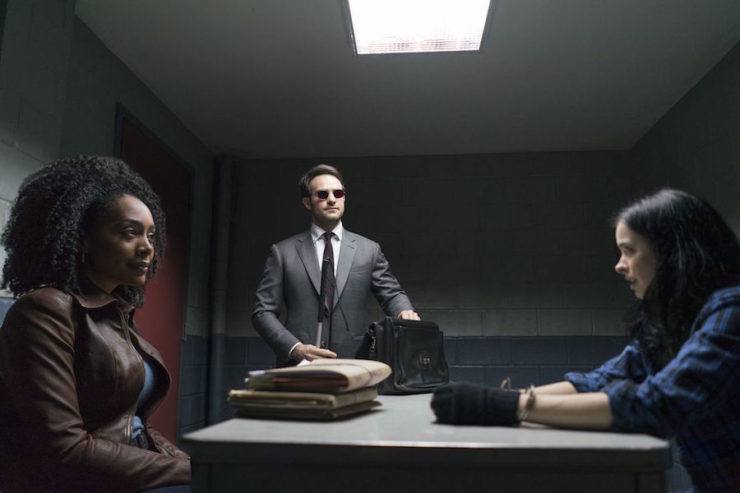
Wing and Knight get their moments in the sun, too. Wing is frustrated by Rand marginalizing her and then finding new playmates, and she pretty much forces herself on the team in the end, and she’s the one who provides the C-4 that stops the Hand once and for all. She also gets some degree of closure by confronting Bakuto again, and killing him for realsies this time.
As for Knight, she’s torn between her duty as a cop and how much she trusts Cage and Temple. In the end, she risks her job in order to dive into the fray with the rest of them, helping Wing and Temple against the Hand, and losing her arm for her trouble. (So Netflix, she’ll get a bionic arm, right? And then we get a Daughters of the Dragon series with Jessica Henwick and Simone Messick kicking ass every week, right? Right?)
Jones’s sidekicks get less to do, though Trish Walker’s radio show does play a small role in the story, and Malcolm’s almost puppy-like loyalty to Jones is always a delight.

Cage and Jones have the least connection to the overall plot—the Hand has been Murdock and Rand’s thing—but it’s made up for in other ways. Cage is both the common sense and the conscience of the team; in the end, he’s the one who’s only on board if they can guarantee that no one who isn’t a member of the Hand will get hurt. He’s also the one who actually captures Sowande, and it’s his plan of attack when he, Jones, and Murdock go down the big hole to rescue Rand. Meanwhile Jones—besides providing the best smartassery—is the one who actually does the most to figure out what’s going on, reminding us that, besides being super-strong, super-obnoxious, and a super-drunk, she’s also a damn good private investigator. Tellingly, she’s the only one to reject the team-up Rand practically begs for when the four of them all are thrown together; just as tellingly, she rejoins them when she does legwork and realizes that the people they’re after have been around since at least the 19th century. Jones and Cage also get the rapprochement that Kilgrave’s manipulations kept them from having in JJ season 1. One hopes that they’ll appear in each others’ respective second seasons, as the pair of them have settled into a friendship that will, one suspects, be good for them both.
In the end, Murdock asks Rand to tell the others to protect his city after he’s gone, since he expected to die with Elektra in the end. There’s no indication that they’re going to officially team up, but at the very least, they’re likely to help each other out when needed.
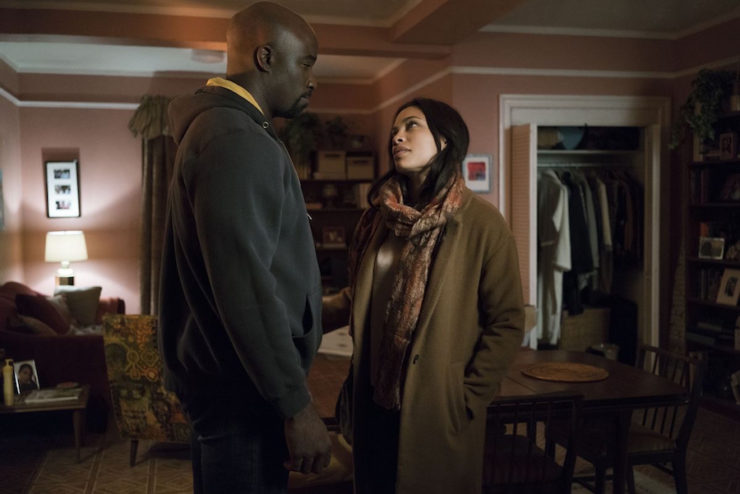
For all that I’ve slagged the plot, The Defenders is still absolutely worth watching. With the notable exceptions of Ramon Rodriguez, who remains pretty and lifeless as Bakuto, and Jones, still the weak link as Iron Fist, the cast is stellar, the characterization is superb, and ultimately, it’s a story about heroes. They all start out reluctant in some way—whether it’s Cage not wanting to take credit, Rand too focused on his guilt, Murdock trying to stay away from the violence, or Jones just wanting to be left alone in her bottle—but they come together in a big way and it’s a joy to see.
Bring on The Punisher…
Keith R.A. DeCandido writes “4-Color to 35-Millimeter: The Great Superhero Movie Rewatch” for this site every Tuesday. He has also written about Star Trek, Stargate, Batman, Wonder Woman, Doctor Who, and other Marvel Netflix series. In addition, he’s the author of a metric buttload of fiction, most recently the Marvel “Tales of Asgard” trilogy featuring Thor, Sif, and the Warriors Three, three Super City Cops eBook novellas about cops in a city filled with superheroes, the Orphan Black reference book Classified Clone Report, and short stories in Baker Street Irregulars, Aliens: Bug Hunt, Nights of the Living Dead, TV Gods: Summer Programming, The Best of Bad-Ass Faeries, and Stargate SG-1/Atlantis: Homeworlds.










